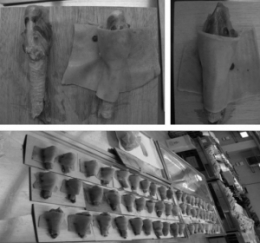Crico: S'entraîner sur un modèle animal est pertinent ?
04/04/2015
Comparison of manikin versus porcine models in cricothyrotomy procedure training
Cho J et Coll. Emerg Med J 2008;25:732-734
--------------------------------------------------------------------------
Le choix du simulateur de tache utilisé pour l'enseignement de la coniotomie reste une vrai question. Modèle humain, animal ou artificiel. Cet article met en avant l'intérêt du modèle animal qui offrirait plus de réalité anatomique. Néanmoins il faut lire ce document avec un peu de recul car la coniotomie est un geste peu fréquemment réalisé, et probablement que la notion de réalisme porte plutôt sur les aspects anatomiques de la région cervicale que sur le réalisme de pratique de geste sur la région cervicale. Encore faut-il pouvoir dans la vrai vie pouvoir disposer d'une filière d'approvisionnement qui souvent se résume au boucher du quartier.
--------------------------------------------------------------------------
Objective: To compare the usefulness for training of a porcine model (larynx, trachea, and pig skin) and a manikin model using a Portex cricothyrotomy kit (PCK).
Methods: In a prospective randomised crossover trial, participants in the airway workshop performed crico-thyrotomy using a PCK on the porcine and manikin models (Tracheostomy Trainer and Case). The porcine model was made with larynxes and trachea from freshly slaughtered pigs and covered with a piece of thinned pigskin stapled to a wooden board.
Participants were asked to assess the following: reality of skin turgor; difficulty with skin penetration, landmark recognition and procedure; reality of the model; and preference for each model using a visual analogue scale (VAS) of 0–10 cm. The VAS scores for each model were compared.
Results: 49 participants were included in the study. Mean (SD) VAS scores for the reality of skin turgor, degree of difficulty with skin penetration and landmark recognition were higher with the porcine model than with the manikin model (7.0 (2.1) vs 4.7 (2.0), 6.4 (2.4) vs 3.6 (2.2), 5.1 (2.2) vs 4.2 (2.5), respectively). There was no difference between the models in the difficulty of the procedure (5.0 (2.4) vs 4.7 (3.2)). The porcine model had a higher VAS score for overall reality and preference of the model (7.1 (2.0) vs 4.8 (2.3) and 7.1 (2.0) vs 4.8 (2.2), respectively).
Conclusion: The porcine model is a more useful training tool than the manikin model for cricothyrotomy with PCK because of its reality and similarity to human anatomy.




Les commentaires sont fermés.